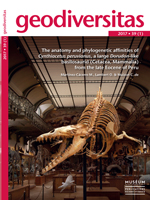Cynthiacetus peruvianus Martínez-Cáceres & Muizon, 2011 is a Dorudon-like basilosaurid (Cetacea, Basilosauridae), being one of the largest members of the family. The holotype of this species is a sub-complete skeleton, which comes from the late Eocene (Priabonian) of the Otuma Formation on the southern coast of Peru. A thorough description of this specimen is presented here. Cynthiacetus peruvianus differs from the other species of the genus (C. maxwelli) in having fewer accessory cusps on the distal and mesial edges of p3 and p4. Its skull shows the general pattern of the basilosaurid skull, which is relatively monotonous across the whole family, but it is much larger than those of Dorudon and Zygorhiza, and slightly smaller and distinctly more slender than that of Basilosaurus. The most characteristic features of C. peruvianus stand on the postcranial skeleton: it presents large vertebrarterial foramina on the cervical vertebrae; it lacks a ventral expansion of the transverse processes of C3-C5; it presents the greatest number of thoracic vertebrae (20) observed in cetaceans; and its first thoracics have an almost vertical neural spine. The second part of the monograph is devoted to evolutionary trends and phylogenetic relationships of Archaeocetes with a special focus on Basilosauridae. Some of the major trends considered concern, the rostrum morphology, the asymmetry of the rostrum, the supraorbital region, the neurocranium, the pelvic girdle and hind limb, and the chevrons. A parsimony analysis confirms the monophyly of the Basilosauridae, which are supported by four unambiguous synapomorphies: the presence of well-defined embrasure pits between the upper incisors, a narrow palate anterior to P4, a cleft on the mesial edge of the lower molars, and more than 13 thoracic vertebrae. In contrast with previous hypotheses, in which Saghacetus was the sister taxon of the Pelagiceti, the results of our analysis reveal this taxon as the most basal basilosaurid. In all the analyses performed Cynthiacetus forms a clade with Dorudon and Basilosaurus, being almost constantly the sister taxon of Basilosaurus.
How to translate text using browser tools
31 March 2017
The anatomy and phylogenetic affinities of Cynthiacetus peruvianus, a large Dorudon-like basilosaurid (Cetacea, Mammalia) from the late Eocene of Peru
Manuel Martínez-Cáceres,
Olivier Lambert ,
Christian de Muizon
ACCESS THE FULL ARTICLE
It is not available for individual sale.
This article is only available to subscribers.
It is not available for individual sale.
It is not available for individual sale.

Geodiversitas
Vol. 39 • No. 1
March 2017
Vol. 39 • No. 1
March 2017




